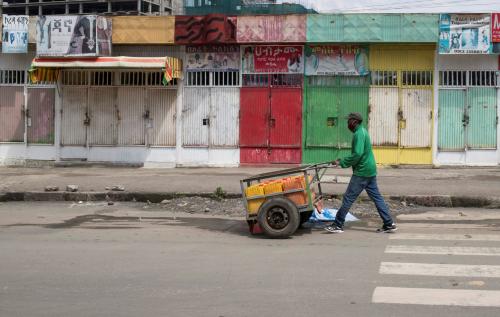The Dodd-Frank Wall Street Reform and Consumer Protection Act (Dodd-Frank Act), which focuses on reforming U.S. financial regulation as a response to the financial crisis, was signed into law on July 21, 2010. Section 1502, which falls in the final ten pages of the 848 page act, imposes additional reporting requirements on U.S. companies regarding their sources of certain “conflict minerals.” The section is intended to address a concern by Congress “that the exploitation and trade of conflict minerals originating in the Democratic Republic of the Congo and adjoining countries (together called ‘DRC countries’) is helping to finance conflict characterized by extreme levels of violence in the eastern Democratic Republic of the Congo, particularly sexual- and gender-based violence, and contributing to an emergency humanitarian situation therein…” Presumably, this provision is the result of strong advocacy by interest groups concerned with restoring peace and stability in the DRC sub-region. Countries covered under this legislation are the contiguous nation states of South Sudan, Uganda, Rwanda, Burundi, Tanzania, Malawi, Zambia, Angola, Congo, Central African Republic, and Democratic Republic of Congo. While the humanitarian underpinnings of this legislation are commendable, much remains to be done.
The presence of this provision in a bill on financial sector reform is, to say the least, unexpected. Although it may have initially seemed a minor addition to such a major reform bill, media attention around it indicates otherwise. Moreover, the Securities and Exchange Commission (SEC) has yet to issue a directive on the provision despite the legislation being passed over a year ago. This reality and recent challenges to the constitutionality of some sections of the Dodd-Frank Act have kept the legislation on the front burner of current policy debates.
Primarily, the Act uses the instrumentality of “name and shame,” and is directed at companies engaging in economic activities in which conflict minerals are “necessary to the functionality or production” of their manufactures. The regulated minerals are together known as “3TG” metals—tin, tantalum, tungsten, gold (and others determined by the U.S. Secretary of State as financing conflict in the DRC countries)—and are modeled after a certification scheme for “conflict diamonds” commonly called the Kimberly Process. The breadth of industries affected includes aerospace, automotive, electronics and communications, jewelry, healthcare machines, and manufacturing conglomerates.
The burden on affected companies is deliberately severe to acknowledge the serious realities for which the provision is intended. For a company to be compliant, it must, in addition to filing three different forms of paperwork with the SEC, publish a “Conflict Minerals Report” in both its annual report and website. The report essentially requires the country of origin to affirm whether its conflict minerals are “DRC conflict-free” and provide evidence proving this conclusion. Therefore, companies will need to conduct supply chain due diligence and, where necessary, perform third-party verification and/or furnish details which may include the mine of origin. If the company is unable to ascertain the source of its conflict minerals, this fact must be disclosed in both its annual report and website.
Two important implementation issues offer insight into whether or not the law will be effective. Both issues—arrangements for compliance monitoring and enforcement machinery—have been delegated to three government agencies: SEC, State Department, and United States Agency for International Development (USAID). To appreciate the compliance challenges which are likely to confront regulators, it is important to consider different stakeholders’ reactions to the legislation. One group, comprised of U.S. businesses and artisanal miners in DRC countries, expressed concern over the adverse consequences on the corporate “bottom line” and on the income of poor miners whom have few alternative employment opportunities. Another group, comprised of U.S. corporations concerned about the victims of violent conflicts in DRC countries, note the costly implications of the legislation, but hope to implement constructive solutions to address the challenges posed.
The National Association of Manufacturers estimates compliance costs will fall between $9 billion and $16 billion, which are significantly higher than the SEC estimate of $71 million. The variation between the two estimates is huge; however, until the SEC finalizes the regulation, these estimates remain speculative and without a solid-basis for determining the true compliance costs. It is reasonable to expect the SEC will be mindful of certain complicating factors that could unnecessarily escalate compliance costs for companies already struggling under trying economic times. Additionally, such diligence will serve to minimize—to the extent feasible—the unintended adverse effects of the provision on people’s livelihood in DRC countries. Locals are already apprehensive that U.S. companies may nearly boycott conflict minerals originating from DRC countries as a matter of expediency. However, corporate anxiety over uncertainties regarding the severity of compliance regulations can be lessened by pointing out that the Conflict Minerals Report requires only a “reasonable” country of origin inquiry. This regulation contains an escape clause for companies struggling with verification issues—if a company is unable to determine the origin of its minerals, it must simply disclose that fact.
U.S. companies’ and local miners’ concerns are well founded; however, the law is intended to force a paradigm shift in the cost-benefit assessment of mining and thus induce the desired behavioral change in the players. By forcing beneficiaries of mining activities to bear the full costs of doing business—which previously fell upon society—the law partially achieves its purpose. Local beneficiaries would now have to consider alternative means of livelihood or participate in the trade in a manner that does not initiate violence. Similarly, companies that trade the minerals may either have to explore alternative sources of 3TG metals that do not fuel conflicts, or devise rules of procurement within the region which are conflict-free.
These are serious issues of not only economic survival, but also life and death. Clearly, the appealing formula is for all sides to craft a lasting solution to mitigate conflict in the sub-region. DRC, however, maintains little authority in the eastern region of the country where this conflict is most pronounced and is, therefore, incapable of stabilizing the zone. Additionally, some adjoining countries, which are expected to aid the peace process, are instead unscrupulously manipulating the disorder to their advantage. Many adjoining countries also knowingly fuel the crisis by exporting products originating within the borders of their neighbors. For example, Uganda has no significant gold resources and yet has historically been an important gold exporter in the sub-region.
Clearly, addressing trade-related drivers of the humanitarian crisis in DRC countries must go beyond value-chain verification by U.S. businesses. Fortunately, Congress has signaled it is aware of this limitation by pushing beyond supply chain due-diligence and has enjoined the Secretary of State to liaise with USAID in formulating a strategy for peace and stability in the sub-region. Recent media coverage suggests that Dodd-Frank has indeed brought increased awareness of the humanitarian crisis and its trade-related dimensions. However, as the law commands, the proposed partial solutions are incomplete and should, in our opinion, incorporate a far-reaching, global strategy on conflict minerals.
Meanwhile, we offer the following suggestions as a call to action for the SEC, State Department, USAID, and the US Congress. They will make the implementation of the regulation more effective and will inform all stakeholders—manufacturers, NGOs and the DRC countries—of possible ways to move towards a lasting solution to the humanitarian crisis.
- The SEC should seize the opportunity to supplement its direct monitoring with whistle-blower support from the NGO community, whom are already interested observers. Although the SEC directly monitors compliance through corporation filings, its audit verification strategy can be improved by co-opting the NGO third-eye.
- It is important that the SEC clarifies any ambiguities surrounding definitions and standards, particularly with regard to audit. Presumably many of these vexing issues would have been tabled during the consultation stage when industry and NGOs were allowed to submit comments for consideration by the SEC. Undoubtedly clarity will reduce the overall cost of compliance and discourage the tendency to subvert the law.
- In its rule making, the SEC may find instructive the OECD Due Diligence Guidance for Responsible Supply Chains of Minerals from Conflict-Affected and High-Risk Areas. This guideline has been widely applauded as an outstanding outcome of a multi-stakeholder process. According to remarks by U.S. Secretary of State Hilary Clinton during the 50th Anniversary of the OECD Guidelines for Multinational Enterprises in May 2011, “… they do bring together labor, civil society, and business to create the broadest possible consensus behind them. This is truly the work of a global policy network in action.” The guideline has been endorsed, among others, by the NGO community and the U.S. State Department.
- As the law currently stands, the most obvious punishment it carries is reputational, although other punitive measures could potentially be specified. Definitively articulated financial consequences for non-compliance will better enforce regulations than a threat to a company’s reputation, and complement threatening non-trivial compliance costs.
- Congress should note that over the long term, coordinated pressure along the entire illicit value chain of conflict minerals would be more effective than a standalone intervention aimed solely at the extractive stage. For armed groups to purchase weapons, it may be necessary to launder part of the money from illicit sales that often involve human rights violation and crime. Therefore, additional remedial measures—such as supporting the global Anti-Money Laundering and Countering of Terrorism Financing (AML/CTF regime)—are indeed helpful. A good starting point would be to lobby state parties to domesticate the United Nations Convention against Corruption as well as support the implementation of Financial Action Task Force (FATF 40+9) recommendations.
- Manufacturers should engage suppliers by enlightening them on how to best implement supply chain due diligence and third party verification. They can also clarify roles and expectations for suppliers as well as specify immediate and long-term implications for ongoing contractual agreements.
- Create a stronger platform to promote U.S./Africa engagement aimed at establishing political order and legitimate regimes in the sub-region. This can be realized through forging a tripartite coalition of governments including the Africa Union, NGOs, and businesses. USAID’s new Community Mining Program, Friends of Congo, and Motorola Solutions for Hope are outstanding examples of ongoing initiatives by governments, NGOs, and businesses, respectively, to address the situation in the DRC from various angles. Harnessing the collective experience of these committed actors increases the likelihood of a breakthrough in the quest for a lasting peace.
- Countries neighboring the DRC must help reduce the conflict minerals trade. Without support from the sub-region, the core problems of the conflict will not be fully addressed. Tanzania, as a DRC country that exports its own gold, has a good reason to partner with the government of DRC to control this problem. Uganda and other complicit states must work towards increasing accountability regarding their involvement in the conflict minerals trade.
Ultimately, resolving the multifaceted crises in the DRC requires coordination within the region and the support of the international community. Dodd-Frank is a good start at the international level. Unfortunately, the lack of a binding global due diligence regime leaves a gap in the fight to end the crisis. Activities of multinational enterprises, who do not face domestic constraints with regard to supply-chain due diligence, remain a challenge to mitigate conflict. This speaks to another reason why a coordinated global effort is an imperative. By working together to establish a lasting peace in the heart of Africa—a global public good—everybody wins: businesses reap cost savings driven by peace rather than by exploitation and opportunism, while locals enjoy peace and stability that are conducive to income growth and job creation.



Commentary
Op-edConflict Minerals: An Assessment of the Dodd-Frank Act
October 3, 2011